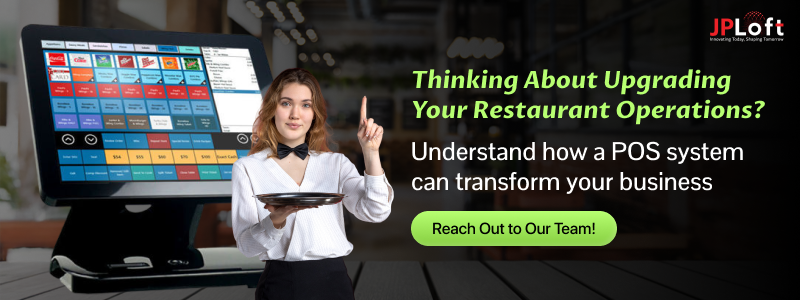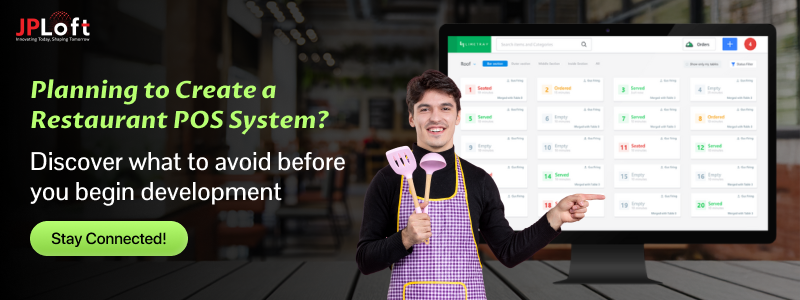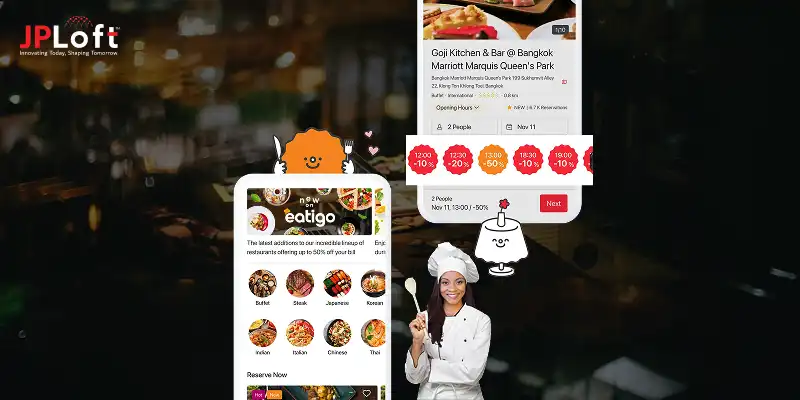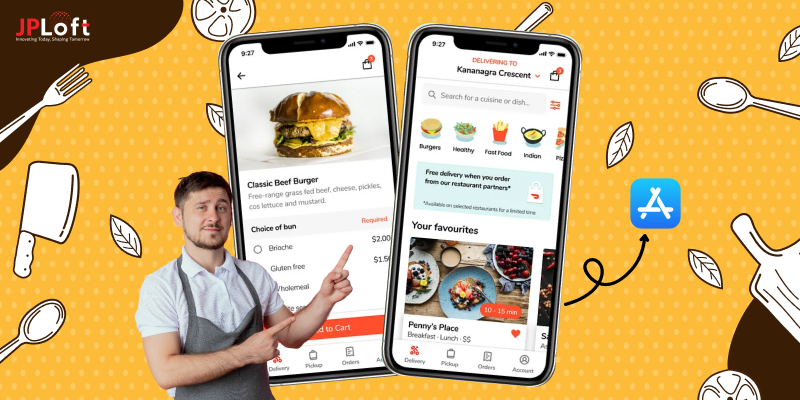In today’s fast-paced restaurant industry, efficiency and customer satisfaction go hand in hand. A robust Restaurant POS System is no longer just a luxury; it’s a necessity for managing orders, payments, and inventory seamlessly.
Many restaurateurs wonder how to build a restaurant POS system? The answer lies in combining smart technology, intuitive design, and real-time analytics to streamline operations.
From tracking sales to enhancing customer experiences, a well-designed POS system can transform the way a restaurant operates. In this guide, we’ll walk you through everything from understanding what a restaurant POS system is, its essential features, and AI integration, to cost, monetization strategies, and future trends.
Key Takeaways
A Restaurant POS System streamlines operations, boosts efficiency, and enhances customer satisfaction through automation and real-time data.
Learning how to create a restaurant POS system helps businesses build a customized, efficient, and future-ready solution that boosts revenue and streamlines operations.
Building a custom POS system allows restaurants to tailor features like menu management, analytics, and payments for better control and performance.
AI integration enables predictive insights, smart recommendations, and automation that elevate overall business productivity.
Understanding cost factors including design, features, AI integration, and maintenance, helps plan a scalable and cost-efficient development process.
Future-ready POS systems will focus on mobility, cloud computing, and AI-driven decision-making for improved restaurant management.
Collaborating with JPLoft ensures expert guidance, innovative solutions, and end-to-end development support to bring your POS vision to life.
What is a Restaurant POS System?
A Restaurant POS System is a powerful tool designed to streamline restaurant operations, from managing orders and payments to tracking inventory and generating reports. If you want to create a restaurant POS system, this solution acts as a central hub connecting the front-of-house and back-of-house activities.
Modern POS systems go beyond simple cash registers; they integrate with kitchen displays, loyalty programs, and analytics dashboards. Understanding the system’s role is key if you’re exploring how to develop a restaurant app for your business. These features help optimize staff efficiency, enhance customer experience, and ultimately increase revenue.
Planning your budget also matters. Considering the cost to develop a restaurant app can ensure your investment aligns with the features and technology you need.
Why Create a Restaurant POS System?
A restaurant POS system is more than just a billing tool; it streamlines operations, improves customer experience, and drives smarter business decisions. By automating key processes and providing actionable insights, it helps restaurants save time, reduce errors, and boost profitability.
A] Streamline Operations
A POS system automates order taking, billing, and inventory tracking, reducing human errors and saving time. If you want to make a restaurant POS system, these automation features allow staff to focus more on customer service, ensuring smooth day-to-day operations.
B] Enhance Customer Experience
Modern POS systems offer features like faster checkouts, loyalty programs, and personalized promotions. This not only increases customer satisfaction but also encourages repeat visits, driving long-term loyalty.
C] Boost Revenue and Profitability
By providing detailed sales analytics, a POS system helps identify best-selling items, peak hours, and customer preferences. Restaurants can make data-driven decisions to optimize menu pricing, reduce waste, and increase overall revenue.
D] Integrate With Other Tools
A restaurant POS can seamlessly connect with accounting software, kitchen display systems, and mobile apps. Many successful restaurants leverage the best restaurant apps to enhance their operations alongside a POS system, creating a unified ecosystem for management.
E] Simplify Inventory Management
Real-time tracking of stock levels prevents over-ordering and reduces food waste. Alerts for low-stock items allow timely reordering, saving costs and ensuring that customers always find their favorite dishes available.
F] Support Business Growth
As restaurants expand, POS systems can scale easily to multiple locations, ensuring consistent processes and reporting. This scalability is crucial for businesses aiming for long-term growth.
G] Enable Advanced Reporting and Insights
Modern POS systems provide detailed insights into sales trends, staff performance, and customer behavior. These actionable insights help owners make informed strategic decisions, improving ROI and operational efficiency.
How Does a Restaurant POS System Work?
A restaurant POS system streamlines the entire workflow from order placement to payment while keeping inventory and analytics up to date in real time. It ensures accuracy, efficiency, and valuable insights, helping restaurants serve customers better and make informed business decisions.
1. Order Placement
The workflow begins when a customer places an order at the counter, via a tablet, or through a mobile app. Staff can quickly enter the order into the POS system, which automatically syncs it with the kitchen display system, ensuring accuracy and reducing delays. If you’re planning how to develop a restaurant POS system?, understanding this seamless order entry process is crucial.
2. Order Processing and Kitchen Management
Once the order is entered, the system categorizes it based on preparation time, priority, and table number. Kitchen staff receive real-time updates, minimizing mistakes and speeding up service. Advanced POS systems can even suggest optimal preparation sequences to enhance efficiency.
3. Billing and Payment
After the meal is prepared, the POS system generates the bill, calculates taxes, and applies discounts or loyalty points automatically. Payments can be processed via cash, credit/debit cards, or mobile wallets. This integrated billing process reduces errors and ensures smooth transactions for both customers and staff.
4. Inventory Tracking
Every order triggers automatic updates in the inventory. Ingredients used are deducted from stock in real-time, helping managers track shortages and avoid overstocking. This reduces food waste and ensures the restaurant runs efficiently.
5. Reporting and Analytics
Modern POS systems collect valuable data on sales, popular menu items, peak hours, and customer preferences. These analytics enable restaurant owners to make informed decisions about menu updates, staffing, and promotions, ultimately boosting profitability.
6. Integration With Other Systems
A POS system often integrates with accounting software, CRM tools, and online ordering platforms. This ensures a unified workflow, giving managers a complete overview of the business from a single dashboard.
7. Customer Insights and Feedback
Some advanced POS systems allow customer feedback to be captured and analyzed, helping restaurants improve service quality and tailor promotions to customer preferences.
Features to Include in a Restaurant POS System
A restaurant POS system should combine essential and advanced features to streamline daily operations and enhance customer service. From menu management to AI-driven analytics, each feature plays a vital role in improving efficiency, accuracy, and profitability.
► Menu Management
A flexible POS system allows restaurants to manage their menus effortlessly. You can add, update, or remove items, set prices, and categorize dishes by type or popularity. Advanced systems let you display allergen information, customize options, and create combo offers. Integrating top restaurant app features ensures a seamless menu experience for both staff and customers.
► Order Management and Table Tracking
Efficient order management lets staff take orders accurately and track them in real time. Tables can be monitored for occupancy and order status, ensuring faster service and minimal mistakes. This feature improves workflow for servers and kitchen staff alike.
► Payment Processing
A modern POS supports multiple payment options, including cash, card, and digital wallets. Automated billing reduces human errors and integrates discounts, taxes, and loyalty points in real time. Secure payment processing enhances trust and provides a smoother checkout experience.
► Inventory Management
Every transaction automatically updates inventory, helping managers track stock levels and reduce wastage. Notifications for low-stock items ensure timely reordering, which prevents shortages and keeps operations uninterrupted.
► Customer Loyalty Programs
Reward systems integrated within a POS help retain customers. Points accumulation, digital coupons, and personalized offers encourage repeat visits. Using insights from AI in restaurant apps, restaurants can tailor promotions to customer behavior, maximizing engagement and revenue.
► Analytics and Reporting
Real-time analytics provide insights into sales, popular items, peak hours, and staff performance. Visual dashboards make it easier for managers to monitor trends and make data-driven decisions that enhance profitability.
► Integration and Third-Party Tools
POS systems should integrate with online ordering platforms, accounting software, and delivery management apps. Ensuring smooth and reliable integration between these tools creates a unified, efficient, and easily manageable restaurant ecosystem.
► User-Friendly Interface
A clean and intuitive interface reduces training time for staff and improves operational efficiency. Touchscreen options, simple navigation, and quick-access buttons make everyday tasks faster and more efficient.
► AI-Powered Features
Incorporating AI helps in predictive ordering, demand forecasting, and personalized recommendations. This not only streamlines operations but also enhances the overall customer experience.
► Security and Compliance
Secure data handling, PCI compliance, and regular updates protect customer information and financial data. Ensuring robust security safeguards both the business and its patrons.
A well-rounded POS system combining these features allows restaurants to build a POS system for restaurants that optimizes operations, reduces errors, and enhances customer satisfaction.
How to Build a Restaurant POS System?
Building a restaurant POS system involves strategic planning, the right technology stack, and an intuitive user interface. From setting clear goals to integrating AI and automation, each step plays a crucial role in creating a robust, efficient, and scalable system tailored to your restaurant’s operations.
Step 1: Define Goals and Requirements
Start by outlining what your POS system needs to achieve. Identify the business objectives, such as improving order accuracy, optimizing staff efficiency, or gaining insights through analytics.
Determine who your end users are (waitstaff, managers, or kitchen staff) and the size or type of restaurant you’re building for. This step forms the foundation of your guide to build a restaurant POS system, ensuring the solution fits both current and future needs.
Also, list essential features like inventory tracking, multiple payment options, and integration capabilities early on to guide the design and development process efficiently.
Step 2: Choose the Right Technology Stack
The technology stack defines your POS system’s performance, scalability, and maintenance needs. Choose a frontend framework such as React or Angular for fast and interactive user interfaces, and pair it with reliable backend technologies like Node.js, Django, or Python for stability and flexibility.
Use databases such as MySQL, MongoDB, or PostgreSQL for efficient data handling. Additionally, ensure compatibility with cloud platforms like AWS or Google Cloud for scalability. Integration with payment gateways, data analytics tools, and third-party APIs should also be planned from the start.
If you are exploring a restaurant app tech stack, these choices directly influence performance, scalability, and overall reliability.
Step 3: Design the User Interface (UI) and User Experience (UX)
A POS system must be simple, fast, and intuitive to reduce training time for staff. Begin with user flow mapping to identify how staff will navigate between menus, tables, and payment screens. Focus on touchscreen-friendly elements, clear icons, and minimal steps to complete tasks like billing or order updates.
Incorporating accessibility and responsiveness ensures a smoother experience across devices. Drawing inspiration from restaurant app ideas can help you introduce innovative design elements such as quick order buttons, visual table layouts, or real-time order status tracking that make daily operations more efficient.
Step 4: Develop Core Features
Once the design is finalized, move into development by building core modules. Start with fundamental components like:
-
Order and Table Management: Enable quick order entry, tracking, and synchronization with kitchen displays.
-
Billing and Payments: Integrate multiple payment methods, auto-tax calculations, and discount systems.
-
Inventory Tracking: Automate updates when ingredients are used or items are sold.
-
Analytics and Reports: Provide sales summaries, peak hour data, and performance metrics.
-
Loyalty Programs: Offer rewards, points, and promotions to retain customers.
Following modular development ensures that each feature can be updated or scaled independently. Emphasize performance, data security, and easy maintenance while developing.
Step 5: Integrate AI and Automation
Integrating AI and automation can elevate your POS system from a basic tool to a smart business solution. AI-powered predictive analytics can forecast demand, optimize menu pricing, and improve resource allocation. Automation, on the other hand, simplifies repetitive tasks such as reordering low-stock items or generating daily sales reports.
These capabilities not only improve efficiency but also provide deeper business insights. Implementing machine learning models for customer recommendations or automated reporting can further enhance user experience and profitability.
Step 6: Testing and Quality Assurance
Testing ensures your POS system performs seamlessly across all scenarios. Conduct functional testing to verify each feature, usability testing to ensure ease of navigation, and stress testing to check system stability under heavy load.
Test integrations with hardware devices like printers and barcode scanners as well. Detecting and fixing bugs early reduces post-launch issues and enhances reliability. Comprehensive QA helps deliver a smooth and frustration-free experience for both staff and customers.
Step 7: Deployment and Training
Once testing is complete, deploy the system to live devices and environments. Gradual deployment allows for monitoring and quick troubleshooting during rollout. Training sessions for staff are essential to ensure smooth adoption, including step-by-step tutorials, live demos, and user manuals.
Effective onboarding minimizes resistance to change and ensures your investment delivers immediate operational benefits.
Step 8: Continuous Monitoring and Updates
After deployment, continuously track performance metrics and user feedback. Regular updates keep your POS system aligned with changing customer expectations and business goals. Implement analytics dashboards to monitor uptime, transaction success rates, and sales data in real time.
Continuous monitoring not only improves functionality but also enhances long-term scalability, keeping your POS system competitive and future-ready.
By following these steps, you can confidently learn how to build a restaurant POS system and develop a solution that enhances operations, improves customer satisfaction, and drives business growth. This comprehensive guide to build a restaurant POS system ensures your platform is technically robust, user-friendly, and built for long-term success.
Use of AI in Building a Restaurant POS System
Integrating AI into a restaurant POS system transforms it from a simple transaction tool into a smart management platform. From predictive analytics to voice ordering, AI enhances efficiency, personalization, and security across every restaurant operation.
► Predictive Analytics for Smarter Decision-Making
Artificial Intelligence enables restaurants to forecast demand by analyzing historical sales, seasonal patterns, and customer behavior. With predictive analytics, managers can adjust menu offerings, optimize staffing, and minimize food waste. This data-driven approach makes operations more efficient and profitable, laying the foundation to develop a restaurant POS system that’s intelligent and adaptive.
► Personalized Recommendations
AI-powered POS systems can recommend dishes based on customer preferences, purchase history, and dining trends. These recommendations enhance the dining experience while increasing average order value. Integrating such personalization helps restaurants strengthen customer loyalty and engagement.
► AI-Powered Chatbots for Order Management
Chatbots can handle table reservations, order confirmations, and customer queries seamlessly. They act as 24/7 virtual assistants, improving customer satisfaction while reducing staff workload. When integrated into the POS system, chatbots ensure smoother communication between customers and restaurant teams.
► Voice Ordering Systems
The integration of AI voice ordering in restaurant app technology is revolutionizing how customers place orders. Voice-enabled POS systems allow hands-free operations, speeding up service and reducing wait times. They’re especially useful for fast-paced environments like drive-thrus or busy dining halls.
► AI Agents for Workflow Automation
The role of AI agents in restaurant apps goes beyond simple automation; they can process payments, manage inventory, and even predict maintenance needs. By learning from data patterns, these agents make operations proactive rather than reactive, minimizing downtime and improving productivity.
► Enhanced Security and Fraud Detection
AI systems continuously monitor transactions to detect anomalies and flag potential fraudulent activities. Machine learning models help ensure payment security and protect customer data, maintaining trust and compliance.
► Customer Sentiment Analysis
AI tools can analyze reviews and feedback in real time to gauge customer sentiment. This insight allows restaurants to refine their offerings and address issues quickly, improving brand perception and customer loyalty.
Integrating AI technologies into your POS system not only modernizes restaurant operations but also offers a competitive edge in a rapidly evolving industry.
What’s the Cost to Build a Restaurant POS System?
When estimating the cost to build a restaurant app development, several factors come into play, ranging from the design complexity and feature set to integrations with AI tools and maintenance support.
Still, to answer the most asked question, “How much does it cost to make a restaurant app?” it would be safe to say the average range typically falls between $25,000 and $60,000.
However, understanding the associated factors helps businesses allocate budgets effectively and set realistic expectations for timelines and performance.
► UI/UX Design
The design phase focuses on creating intuitive, user-friendly interfaces for both staff and customers. A well-planned restaurant app design ensures smooth navigation for billing, menu management, and order tracking. On average, design costs range from $3,000 to $8,000, depending on customization.
► Core Development
The heart of your POS system lies in its backend and frontend development. Features like billing, table management, and analytics dashboards typically cost between $10,000 and $25,000, depending on the platform (web, iOS, or Android).
► Advanced Features & AI Integration
Integrating advanced tools such as inventory management, staff scheduling, or AI-based analytics can increase the cost to develop a restaurant app by $5,000–$12,000. Features like smart recommendations, demand forecasting, and predictive ordering make your POS system stand out.
► Third-Party Integrations
Payment gateways, loyalty programs, and accounting tools require seamless API integration, adding another $3,000–$7,000 to the project.
► Testing & Quality Assurance
Rigorous testing ensures reliability and performance. Manual and automated testing combined can cost between $2,000 and $5,000, depending on the app’s complexity and testing cycles.
► Maintenance & Support
Continuous updates, bug fixes, and performance optimization are crucial for smooth operation. The ongoing maintenance cost is approximately $1,000–$2,500 per month, ensuring consistent uptime and data security.
Estimated Cost Table
|
Component |
Estimated Cost (USD) |
|
UI/UX Design |
$3,000 – $8,000 |
|
Core Development |
$10,000 – $25,000 |
|
AI Integration & Advanced Features |
$5,000 – $12,000 |
|
Third-Party Integrations |
$3,000 – $7,000 |
|
Testing & QA |
$2,000 – $5,000 |
|
Maintenance & Support (Monthly) |
$1,000 – $2,500 |
|
Total Estimated Cost |
$25,000 – $60,000+ |
Understanding how reservation-specific features and workflows differ from POS systems can offer valuable perspective during development. Exploring factors such as the cost to build a restaurant reservation app like OpenTable also helps in making informed decisions about budgeting, integrations, and overall system scalability.
Monetization Strategies to Include in Building a Restaurant POS System
Monetization defines how your restaurant POS system turns efficiency into profit. When you create an on-demand POS system for restaurants, applying effective mobile app monetization strategies ensures your solution not only boosts restaurant performance but also drives long-term business growth.
1. Subscription-Based Model
A popular model for SaaS-based POS systems, this approach allows restaurants to pay a fixed monthly or yearly fee. It ensures predictable recurring revenue for you while providing clients with regular updates and premium support.
Successful SaaS startups create an On-demand POS System for restaurants using flexible subscription tiers tailored to restaurant size and operations.
This model is particularly beneficial when you plan scalability from the start, as it aligns with strategies on how restaurant apps make money, focusing on creating recurring value for users while supporting long-term growth.
2. Commission on Transactions
Here, the platform earns a small percentage on each completed order, reservation, or payment. It’s an excellent model for those integrating online ordering or delivery modules.
When you create an On-demand POS System for restaurants, this approach incentivizes you to help your clients grow because their success directly boosts your revenue.
3. Pay-Per-Feature Model
This flexible structure lets restaurants pay only for the tools they use, such as AI-powered analytics, table management, or digital loyalty programs.
It appeals to small or mid-sized restaurants that want to control their costs while enjoying premium add-ons.
4. In-App Advertising and Promotions
If your platform achieves scale, in-app advertising can unlock an entirely new income stream. Local suppliers or food brands can promote their offerings directly to restaurant owners through ad placements within your POS dashboard.
Many modern startups create an On-demand POS System for restaurants designed as a hybrid business model combining SaaS and ad-based monetization.
It’s a strategic choice that complements sustainable digital business practices as you will observe while exploring how to start an online restaurant business, where diversification is key to long-term profitability.
5. SaaS White-Label Licensing
Licensing your POS solution to third-party resellers or businesses under a white-label model can significantly expand your market reach. You handle development and maintenance, while others handle branding and sales, creating a win-win setup.
Future Trends of Restaurant POS Systems
The restaurant industry is rapidly evolving, and POS systems are at the heart of this transformation. Modern technologies are reshaping operations, enhancing customer experiences, and boosting business efficiency.
► Mobile POS Solutions
Mobile POS (mPOS) systems are transforming restaurant operations by enabling staff to take orders and process payments directly from tablets or smartphones. This flexibility reduces wait times and enhances customer experience.
Restaurants adopting mobile POS solutions can serve more customers efficiently, aligning with recommendations in the Restaurant POS System Development guide.
► Cloud-Based Systems
Cloud technology allows POS systems to store data securely offsite, ensuring accessibility from multiple locations. Real-time updates, automatic backups, and remote management are major advantages.
Cloud integration also supports scaling your operations without additional infrastructure costs, as highlighted in many modern Restaurant POS System Development guide strategies.
► AI-Powered Analytics
Artificial intelligence is revolutionizing how restaurants leverage data. Predictive analytics can forecast demand, optimize inventory, and personalize customer interactions.
AI tools embedded in POS systems provide actionable insights, helping managers make informed decisions that boost revenue and operational efficiency.
► Enhanced Reporting & Business Intelligence
Advanced reporting features allow restaurants to monitor sales trends, staff performance, and customer behavior.
Interactive dashboards and visual analytics make it easier to identify opportunities for improvement and refine business strategies in real time.
► Omnichannel Integration
Future POS systems will seamlessly integrate with online ordering platforms, delivery apps, loyalty programs, and CRM tools.
This creates a unified ecosystem that enhances operational efficiency and customer satisfaction.
► Security and Compliance Enhancements
With increasing cyber threats, POS systems will focus on stronger encryption, PCI compliance, and data protection measures. These safeguards ensure customer trust while meeting regulatory requirements.
► Trends in Digital Payments
Contactless payments, digital wallets, and QR code payments are becoming standard. Integrating these into POS systems will be crucial for meeting evolving customer expectations and improving transaction speed.
By keeping up with these innovations, restaurants can future-proof their operations and stay competitive. Businesses looking to implement modern features should also study restaurant app development trends to ensure their POS systems remain innovative and adaptable.
Challenges in Creating a Restaurant POS System
Building a Restaurant POS System is a complex process that requires careful planning, technical expertise, and operational insights.
While the benefits are significant, developers and restaurateurs often face multiple challenges that can impact the system’s efficiency, adoption, and long-term success.
1. Technical Complexity
Developing a robust POS system requires seamless integration of multiple modules, including order management, payment gateways, inventory tracking, and analytics. Ensuring the system is scalable, secure, and bug-free is crucial.
When considering Restaurant POS System Development, technical hurdles like server management, API integrations, and AI implementation can increase time and cost.
2. User Adoption and Training
Even the most advanced POS system is only effective if staff can use it efficiently. Training employees on new interfaces, managing resistance to change, and providing continuous support are critical steps.
Poor adoption is a common reason why POS projects fail, similar to challenges highlighted in Why restaurant apps fail.
3. Regulatory Compliance and Security
POS systems handle sensitive customer and financial data, which must comply with PCI standards, GDPR, and local regulations.
Ensuring data privacy, encryption, and secure payment processing is non-negotiable, yet it remains a challenge for many developers engaged in Restaurant POS System Development.
4. Integration with Existing Systems
Many restaurants already use legacy systems for inventory, accounting, or online ordering. Integrating a new POS system with these platforms can be technically challenging.
Failure to do so can disrupt operations and reduce ROI, emphasizing the importance of proper planning and technical alignment with restaurant app development challenges.
5. Customization and Scalability
Restaurants vary in size, menu complexity, and operational workflow. Building a POS system that is flexible enough to scale and customize without increasing complexity requires careful architecture and iterative development.
6. Market Competition and Feature Parity
New POS systems must compete with established solutions offering advanced features. Ensuring your system remains competitive while delivering unique value requires research, innovation, and continuous updates, similar to considerations when attempting to build an app like TheFork.
7. Cost Management
Balancing feature-rich development with budget constraints is a major challenge. Including AI, analytics, and integrations can increase costs significantly, making careful financial planning essential.
Overcoming these challenges requires strategic planning, skilled development, and ongoing support, ensuring that your Restaurant POS System Development investment delivers efficiency, profitability, and customer satisfaction.
Partner with JPLoft and Create a Restaurant POS System
Looking to transform your restaurant operations with a cutting-edge POS system? JPLoft offers end-to-end solutions to create a restaurant POS system tailored to your business needs.
From intuitive design and seamless integrations to AI-powered features and real-time analytics, we ensure your POS system drives efficiency and customer satisfaction.
Our team leverages proven strategies and the latest technology to deliver scalable and reliable solutions. Partner with a trusted restaurant app development company to bring your vision to life, streamline operations, and stay ahead in the competitive restaurant industry.
Conclusion
Building a robust Restaurant POS System is no longer optional, it’s essential for streamlining operations, enhancing customer experience, and boosting revenue.
By following a structured approach, restaurants can learn how to build a restaurant POS system efficiently, integrating features like AI-powered analytics, mobile POS, inventory management, and loyalty programs.
Understanding costs, monetization strategies, and future trends ensures your system remains scalable and competitive.
Investing in a well-designed POS solution allows businesses to reduce errors, improve operational efficiency, and deliver a seamless dining experience.
With careful planning, leveraging a Restaurant POS System Development guide, and focusing on innovation, you can create a system that transforms restaurant management and drives long-term success.
FAQs
A Restaurant POS System is a software solution that helps manage orders, payments, inventory, and reporting, streamlining both front-of-house and back-of-house operations.
Building a Restaurant POS System involves planning your requirements, selecting the right tech stack, designing a user-friendly interface, developing core features, integrating AI if needed, testing thoroughly, and deploying with ongoing maintenance and support to ensure efficiency and scalability.
Depending on complexity, features, and integrations, development typically takes 3–6 months for a full-featured system.
Yes, modern POS systems can integrate with online ordering, delivery platforms, loyalty programs, and accounting tools for seamless operations.
Not all, but AI-powered POS systems offer predictive analytics, personalized recommendations, and automation to enhance efficiency and customer experience.
Custom POS systems usually have higher upfront costs but provide flexibility, scalability, and features tailored to specific restaurant needs, offering long-term ROI.













Share this blog